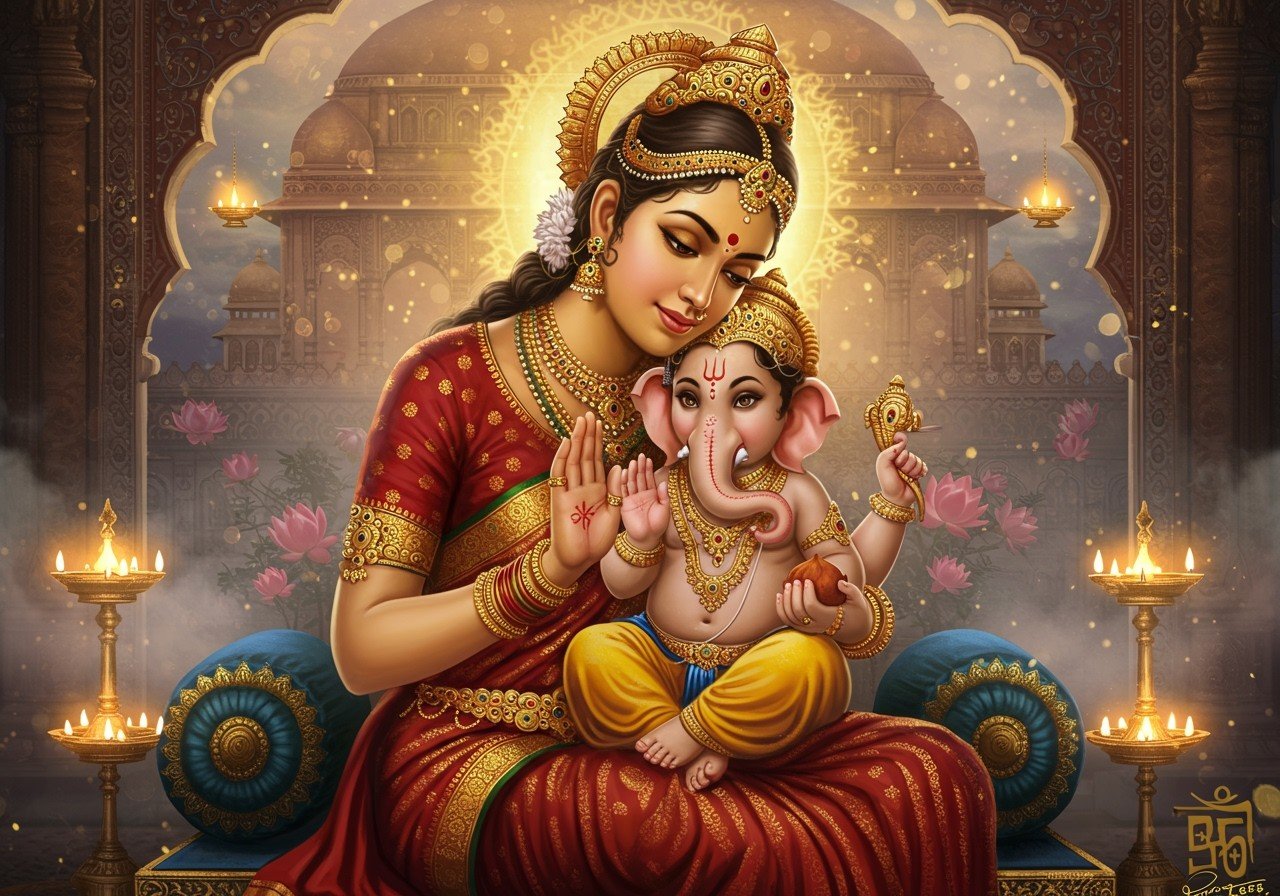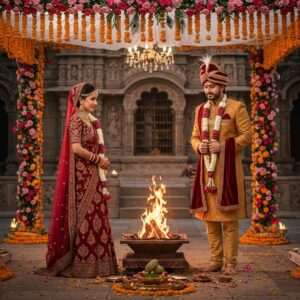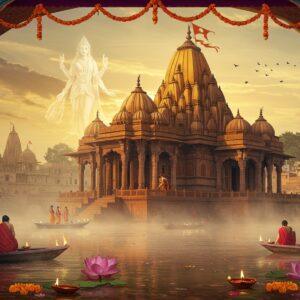The Divine Origins of Parvati and Ganesha’s Story

In Hindu mythology, the story of Parvati and Ganesha is a timeless narrative that highlights the deep bond between a mother and her child. This tale is not just about the creation of a deity but also a reflection of maternal love, devotion, and the complexities of family dynamics within the divine realm. Understanding this story provides insights into Indian traditions and cultural heritage, making it a cherished part of many households. The story finds its roots in ancient texts like the Shiva Purana and Skanda Purana. These scriptures detail Parvati’s longing for a child, a universal desire that transcends even the divine realm. Set against the backdrop of Mount Kailash, the divine abode of Shiva and Parvati, this narrative holds a significant place in Hindu cosmology. It highlights the Trimurti—Brahma, Vishnu, and Shiva—and shows where Ganesha fits within the Hindu pantheon.
Parvati Creates Ganesha
Parvati’s deep longing for a devoted child led her to create Ganesha. Using turmeric paste, she crafted a boy from her own essence, imbuing him with life and love. This act symbolizes purity, love, and the potent force of maternal instinct. Turmeric, with its vibrant hue and purifying properties, holds a sacred place in Hindu rituals, representing purity, auspiciousness, and spirituality. Creating Ganesha was an act of divine feminine power, a testament to Parvati’s independence and strength. It highlights a mother’s autonomy in giving life and shaping destiny. Parvati’s creation serves as a powerful representation of the strength of maternal love, shaping the perception of motherhood and feminine power in Hindu culture.
A Fateful Encounter with Shiva
While Parvati bathed, she tasked Ganesha with guarding the entrance, a symbol of her trust and the sanctity of their private space. Unaware of Ganesha’s existence, Shiva returned home, only to find himself barred entry by this unfamiliar figure. Anger flared as he attempted to enter, leading to a tragic misunderstanding with profound consequences. Shiva, perplexed by the presence of the unknown youth, ordered his forces to remove Ganesha. But Ganesha, imbued with his mother’s divine power, proved an insurmountable obstacle. Finally, Shiva himself engaged the valiant youth. In a moment of unrestrained fury, he beheaded Ganesha, a tragic consequence of misunderstanding and impulsive action.
Grief, Remorse, and Resurrection
Discovering Ganesha’s fate, Parvati’s grief was inconsolable. Her sorrow resonated through the heavens, a testament to the unbreakable bond between mother and son. Demanding that Shiva rectify his grave error, Parvati’s anguish moved Shiva to remorse and action. Recognizing the magnitude of his mistake and the depth of Parvati’s pain, Shiva vowed to restore their son. He dispatched his followers on a quest to find a replacement head, instructing them to bring back the head of the first creature they encountered facing north. They returned with the head of an elephant, a creature known for its wisdom and strength.
The Elephant Head: Symbol of New Beginnings
Shiva, in a display of divine power and compassion, attached the elephant’s head to Ganesha’s body, breathing life back into him. This act of restoration transformed Ganesha, imbuing him with new symbolism and significance. Ganesha’s elephant head became a powerful emblem of wisdom, strength, and the promise of new beginnings. This transformation signified forgiveness, redemption, and the cyclical nature of life and death. Shiva, acknowledging Ganesha as his son, bestowed upon him the esteemed title of “foremost among the gods,” leader of all the ganas, solidifying his place within the divine hierarchy.
Parvati and Ganesha: An Enduring Bond
The image of Parvati with Ganesha is a powerful representation of maternal love and devotion. This depiction, often seen in homes and temples, serves as a visual reminder of the strong bond between mother and son. Celebrated during festivals like Ganesh Chaturthi, this relationship embodies the quintessential mother archetype in Hindu mythology, reflecting enduring themes of love, protection, and the nurturing power of motherhood. Parvati’s nurturing role influences cultural practices, emphasizing the importance of family, devotion, and the transmission of values across generations. Her bond with Ganesha resonates deeply within Hindu culture, a timeless reminder of the power of maternal love and its enduring impact on individuals and communities.
Cultural Significance and Poojn.in
The story of Parvati and Ganesha has deeply influenced Hindu religious and cultural practices. It is integrated into daily rituals, reinforcing values of wisdom, prosperity, and the importance of overcoming obstacles. Artistic depictions of Parvati and Ganesha abound, from intricate temple sculptures to vibrant contemporary art pieces. Poojn.in offers a wide selection of products to honor these deities. You can find beautiful murtis (Lord Ganesha idols and Goddess Parvati idols), as well as other puja items. The tale is a cornerstone of Indian households, serving as a vehicle for teaching cultural values and underscoring the importance of family. Ganesha’s presence, often invoked at the commencement of new ventures, symbolizes success and auspiciousness, a testament to his role as the remover of obstacles. Understanding this narrative provides invaluable insights into Indian traditions and cultural heritage, highlighting the timeless bond between mother and child, a connection that continues to inspire and resonate within countless households.
Explore the divine connection between Parvati and Ganesha with The Many Forms of Lord Ganesha and Goddess Lakshmi Beyond Wealth and Prosperity on poojn.in. Deepen your understanding of Hindu mythology and discover how these deities play a crucial role in Indian culture.
Frequently Asked Questions
How did Parvati create Ganesha? Parvati fashioned Ganesha from turmeric paste, breathing life into this effigy and establishing a profound mother-son connection. This act demonstrates the divine power inherent in motherhood and the sacred significance of turmeric in Hindu traditions. Turmeric is used for many religious ceremonies because of its purifying quality.
Why did Parvati create Ganesha? Driven by a desire for a loyal protector and companion, Parvati created Ganesha to guard her privacy while she bathed. This act highlights the universal longing for companionship and the inherent maternal instinct to protect and nurture. This underscores the importance of personal space and the role of a guardian in maintaining it.
What is the significance of Ganesha’s elephant head? Following a tragic misunderstanding, Shiva replaced Ganesha’s original head with that of an elephant, a creature renowned for its wisdom and strength. This transformation symbolizes new beginnings, forgiveness, and the acceptance of unforeseen change. The elephant head itself represents wisdom, intellect, and good fortune.
How is the story of Parvati and Ganesha celebrated in Indian culture? This divine narrative plays a central role in Ganesh Chaturthi, a vibrant festival dedicated to Lord Ganesha. This celebration reinforces family bonds, honors the mother-son relationship, and expresses devotion through rituals and communal gatherings. Families come together to create statues of Ganesha, offer prayers, and celebrate with feasts and cultural performances.
Poojn.in stands as your trusted partner in observing these traditions. We offer a thoughtfully curated collection of deity idols, puja essentials, and other sacred items to enhance your spiritual practices. We believe in maintaining the authenticity and purity of religious practices by offering high-quality, traditionally made items.


